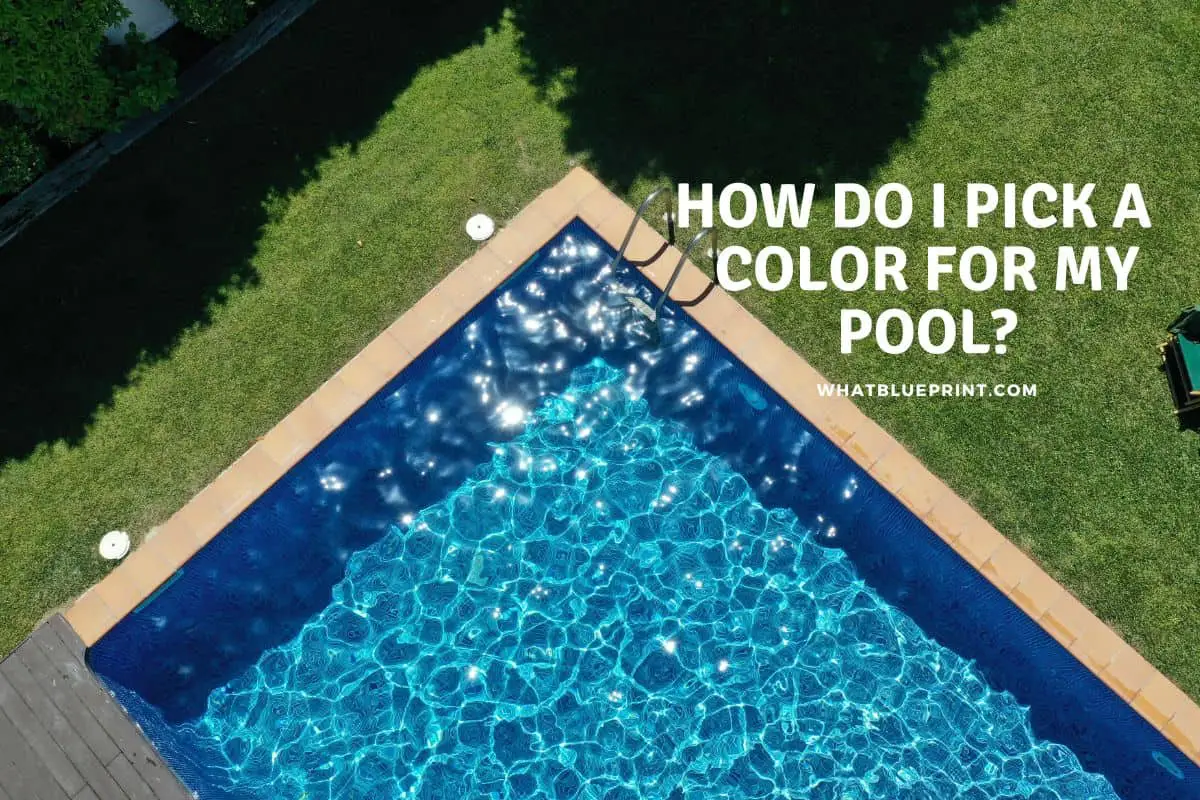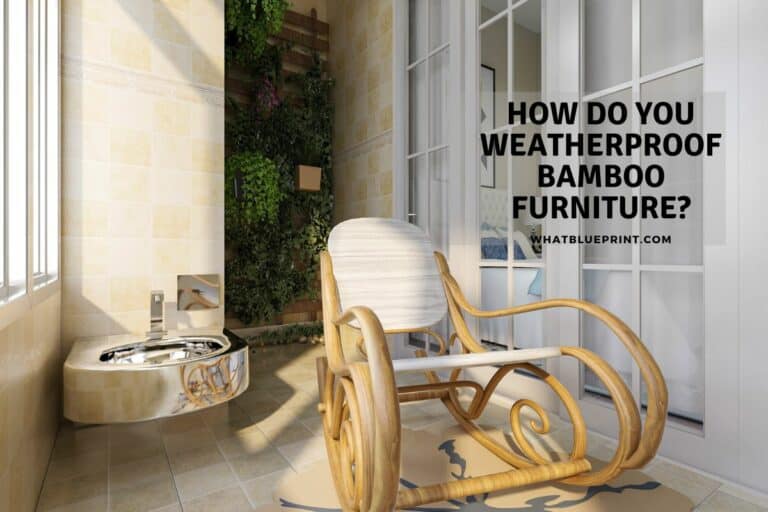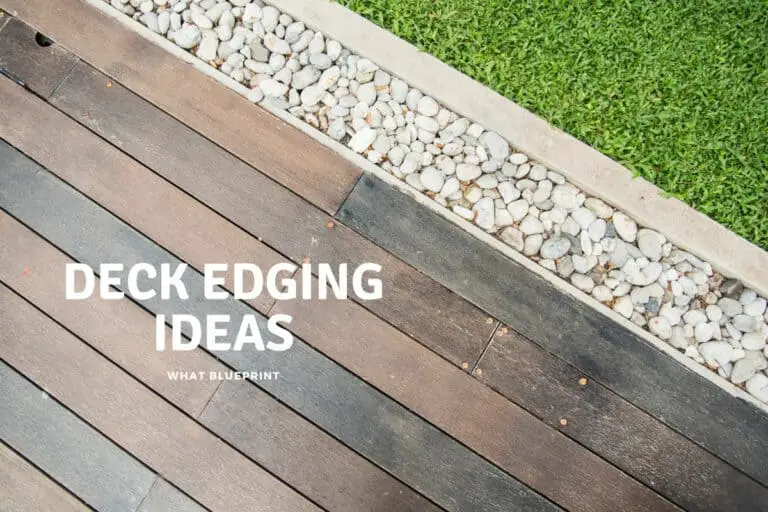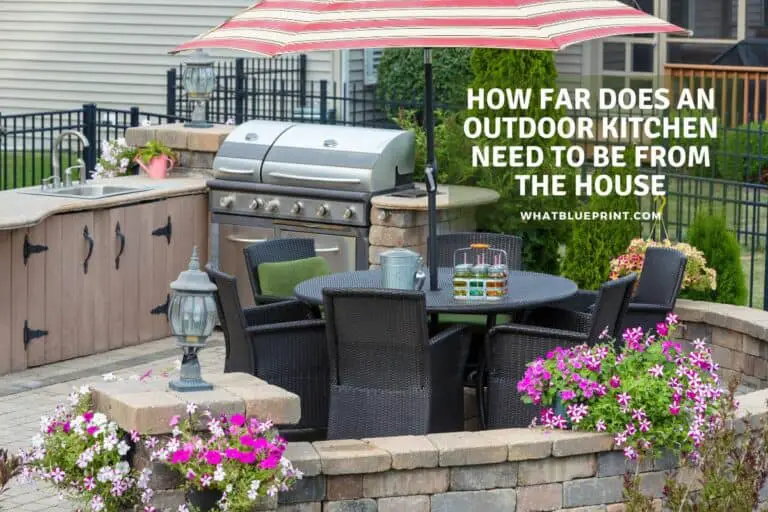How Do I Pick A Color For My Pool?
Designing pools can get quite tricky, especially if this is the first pool that you own. Having a pool comes with all sorts of considerations you’ll need to make. Of course, we want the best-looking pool we can get, so the question is, how should you pick your pool’s color?
The color of your pool will be affected by factors such as its size, depth, immediate environment, and weather conditions. The surface color of a pool mainly comes from the pool’s finish. You should pick a color that compliments your outdoor areas while at the same time also helps with maintenance work.
The pool color that most people refer to is actually from the pool’s plaster. Most pools are finished with Portland cement tiles, as they’re great for holding water and swimming in, that are dyed to give pools their color.
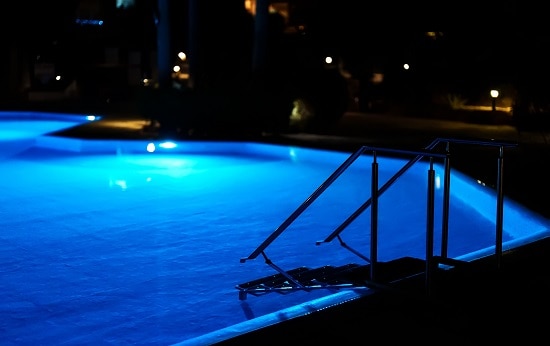
How Do I Pick A Surface Color For My Pool?
Remember that you’re not changing the color of the water with pool plaster. Instead, you’re tinting it. Since we’re not coloring the water, you can expect any changes in the water will change how our pool plaster tints it.
This is important for selecting the surface color of your pool because, in most cases, environmental factors will significantly change how your pool looks. With that said, we’ll have to look into how this phenomenon happens and how to use it to our advantage.
For picking a color for a pool, here are the following factors that you should consider:
- Type of Pool
- Immediate Environment
- Maintenance
- Climate
- Nearby finishes
The first choice you’ll have to make is whether you’ll be going with a light color or a dark color for your pool’s surface. The tone of colors will generally affect how your pool is received and how the color will play a role in how your pool interacts with environmental factors.
How does surface color affect my pool?
We all know that colors carry specific properties in them. We see color based on how an object absorbs and reflects light, which pretty much means that surface color is affected by how light interacts with our pools.
- Temperature
As mentioned earlier, we see color based on how it interacts with light. The lighter the color, the more it reflects light, while darker colors absorb light. A darker-colored pool will absorb and retain more heat than a lighter pool.
We want to keep an ideal temperature of around 80 degrees Fahrenheit in a pool. Whether in a tropical or a temperate climate, the surface color you choose for your pool should help it be more energy efficient.
- Visibility
Visibility helps us better get a look at the current condition of our pool. Environmental factors ranging from leaves, wildlife, debris, etc., are easier to spot in a lighter-colored pool. This can make cleaning more manageable, but it also means that a light-colored pool will appear dirtier faster than a dark-colored pool.
Remember also that visibility also changes with depth. A deeper pool will receive less light, and thus, your pool’s floor won’t be as seen.
- Maintenance
Pool maintenance involves more than just cleaning up debris. You also must consider factors such as chemically treating the water, filtration systems, water circulation, and many more.
Color plays a role because it can indicate the quality of the water. It’s easier to see changes in the water’s color in lighter pools than in dark pools. Typically, any problem with the utilities in our pool will reflect in the water’s quality.
- Safety
It’s easy to forget that pools can get accident-prone if not designed or used correctly. Safety features such as pool railings, steps, alarms, nets, etc., are there to protect users. For private pools, this is important because you probably do not have an active lifeguard on duty whenever you swim.
Even if you have a shallow pool, remember that children may not be that good at swimming, so having safety features easily seen is a great plus. In terms of color, it might be good to have some indication as to where these safety features are located at.
- Aesthetic
We all want a pool that looks good, and it should also match the rest of our spaces. Whether indoor or outdoor, the surrounding finishes around your pool are what’s going to frame it.
The color you choose will, of course, play a role in how people see your pool. It only makes sense to get a color that complements or contrasts your pool’s surroundings.
Choosing the right color helps your pool function better while at the same time also allowing you to use it better as well. You can make any pool color work in many ways, so you must understand how to make it work.
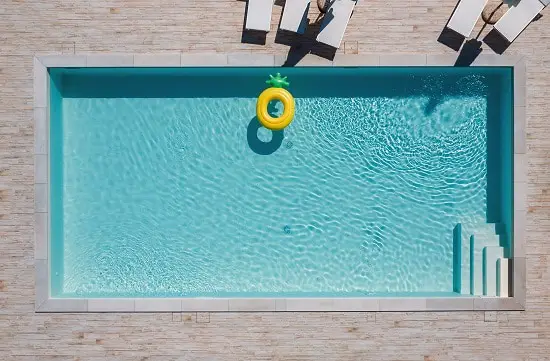
Pool Plaster: What is it?
Pool plaster, as the name implies, is plaster specifically made to work well underwater. Regular plaster involves mixing gypsum, cement, and water, while pool plaster contains other additives that make it more resilient.
Aside from additives, dyes and other decorative elements can also be added. There are hundreds of different pool finishes that you can go with. Most pool plasters have a laminated finish that keeps them smooth and prevents the pool floor from scratching our feet.
There are specific interactions that can affect the quality of your pool plaster:
- Ph levels of the water
- Calcium levels of the water
- Mineral Deposits
- Temperature
You can also tell that something is off with your pool’s plaster based on its coloring. Chemical reactions and physical dents will cause plaster’s color to change based on what’s happening. This is another factor to consider, in line with visibility, when choosing what color to go with to help you better spot any problems with your pool down the line.
Other types of Pool Finishes
Pool plaster is often the most common type of finish for pools due to its low expenses and ease of construction. If you’re looking to invest a bit more into your pool, there are other finishes you can also try. Here’s a breakdown of the different types of pool finishes:
- Stone Finish
Stone finishes are just plaster finishes with a mixture of aggregate added to them. Aggregates can range anywhere from stone pebbles, quartz, marble, etc.
Adding stones with your plaster does provide some benefits; they’re naturally resistant to molding while providing slip protection.
- Tile Finish
A tile finish is the most durable and offers the most design choices compared to other pool finishes. However, these benefits come at a cost, as tile is the most expensive finish you can get for a pool.
If you find tile too expensive, you can simply have it installed only in certain parts of your pool to act as an accent.
Remember that surface color depends on light reflecting from your pool’s finish. Although the shade these finishes produce is somewhat the same, the difference lies in the user experience and the pool’s aesthetic.
if you are thinking of adding a pool to your terrace or outside space check out or advice and tips here and below.
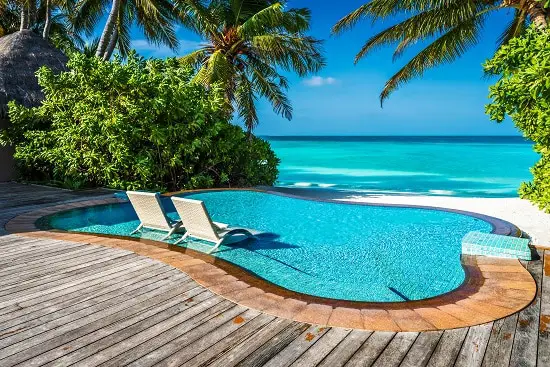
How to change the surface color of my pool?
For those who plan on installing new pool plaster or doing a complete makeover, it helps to know the step-by-step process of installing it—installing pool plaster costs around $3000, which will change depending on the size of your pool and the cost of labor in your area.
Here’s a brief breakdown of how a pool gets replastered:
- Preparing the Pool
Firstly, the pool is drained and relieved of any hydrostatic pressure. An inspection takes place to assess the current condition of your pool before moving on to the next step.
- You must remove any utilities, current finishes, and other installations to make way for the new plaster.
- Installing the Plaster Once the pool has been prepared, you can now begin plastering. To qualify for plastering, you’ll have to apply bonding adhesives to ensure your plaster sticks. A new plaster finish is applied throughout the pool with a thickness of around ½ inch.
- Finishing Finishing is probably the most essential part of this project. You want your pool to look good and feel good to use, and this is primarily where finishes come in. Firstly, you’ll need to smoothen out the plaster applied before moving on to installing tiles.
- From here, remember to place back any previous installations that you have. Depending on your new plaster finish, you might need to purchase new ones that are more compatible with the new design.
- Refill you should do a final inspection before you refill the pool. We must address any cracks or hollows to ensure our pool doesn’t run into problems such as stains, molds, etc.
When refilling a newly plastered pool, you must watch out for acidity. You’ll be breaking in your plaster, so the conditions must be just right.
This type of project takes around 7-10 days to complete. Generally, it’s not too difficult to do DIY, but it does help to hire professionals to evaluate your pool. Changing the finishes surrounding your pool might also be a good idea to further give that new look.
You can check out materials for pool furniture that will complement your pool here and below as well.

How does Pool lighting affect surface color?
It may seem like your pool’s color is entirely dependent on the color of its plaster, but this is not the case. Remember that we perceive objects through how they reflect or absorb light.
As such, changing your pool’s lighting is also a viable way to change its surface color. Of course, this can only really be done once there’s less light interference from daylight. Pool lighting is considered a safety feature as it improves visibility.
For a quick rundown, the lighting level of a pool should be around 300-500 lux which is around the same as a typical kitchen. Pool lighting can’t just be placed wherever; the way light refracts under water can cause problems if designed poorly.
For practical purposes, most pools are often equipped with lighter-colored lights, especially for larger-sized pools. Smaller pools can get away with funkier lights(Red, Green, Purple, etc.) since the distribution light is much more compartmentalized.
Pool lights don’t play much of a role in maintenance since most work is done during the day. To maximize pool lights, consider them as ambient lighting sources for your outdoor spaces at night.
Different types of surface colors for pools
If you’re looking for a place to start, there are common finishes that work well in almost any setting. Generally, most designers aim to get surface color that somewhat replicates that of natural bodies of water( Ex. Rivers, Lakes, Oceans, etc.). These are the most common colors used to achieve these looks:
- White
- Blue
- Green
- Grey
- Black
- Tan
- Brown
Notice how the colors in this list are primarily made up of natural colors that can be found in nature. Using these colors works well in almost any setting because they tend to blend well with the outdoors automatically.
Don’t forget that darker surface colors for a pool increase the water’s reflectivity while lighter-colored pools instead show the water’s movement more.
Pool Maintenance To Maintain Surface Color
Before we end this article, there are a few tips that you should know about pool maintenance. Although the surface color for pools is mainly from the finishes, the water itself also needs to be clear so that light can travel through it. Here’s a quick list of things to look out for in pool maintenance.
- Test your water regularly.
- Check on your pumps and filters.
- Clean your skimmers
- Brush off sediments and algae
- Routinely remove any leaves or debris
It’s recommended that you do maintenance work for your pool every week. You may need to hire a professional now and then to treat the water with specialized tools and chemicals.
Having a water feature like a pool is an awesome addition to your outdoor space, we have a a collection of articles if you are thinking of adding one to help you get started linked below.
- How much does it cost to build a pool on a terrace
- Best ways to put furniture around a pool
- how far should a fire pit be from a pool
- best pool lounger material
- how to pick a pool color
- Can a balcony hold an inflatable pool
Conclusion
You should pick the surface color of your pool based on compatibility, practicality, and preferred design. Pool color serves multiple functions while making pools much more enjoyable. Surface color comes from the reflection of your pool’s plaster, so it’s crucial to maintain it to retain its color.
You could always think about an inflatable pool if you have less space as well.
Sources
- https://intheswim.com/eguides/plaster.html
- https://poolonomics.com/pool-finishes/
- https://sublimepools.net/blog/pool-plastering-a-complete-guide-on-what-to-expect-when-plastering-your-pool/
- https://www.piscine-global-europe.com/en/blog/2017/06/mastering-pool-design-control-color
- https://www.designingbuildings.co.uk/wiki/Swimming_pool_construction#:~:text=A%20hole%20is%20excavated%2C%20the,is%20constructed%20around%20the%20perimeter.
- https://www.hayward-pool.com/shop/en/pools/weekly-maintenance
- https://poolonomics.com/pool-plaster-color/

